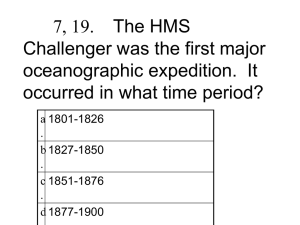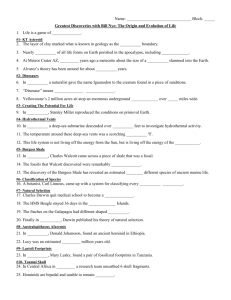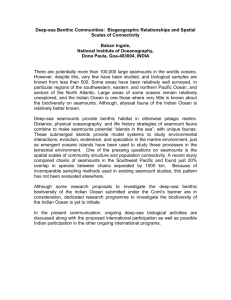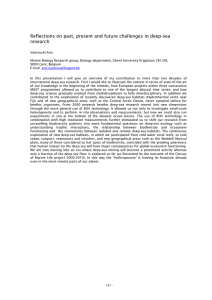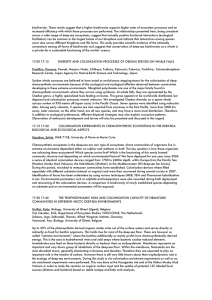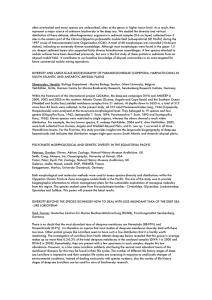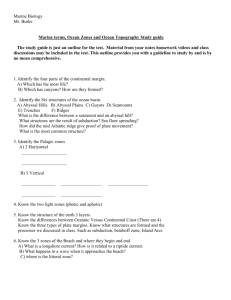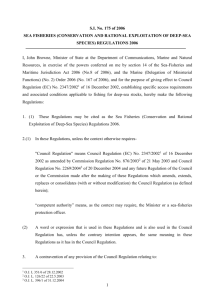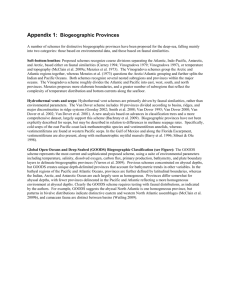Historical perspective of deep
advertisement
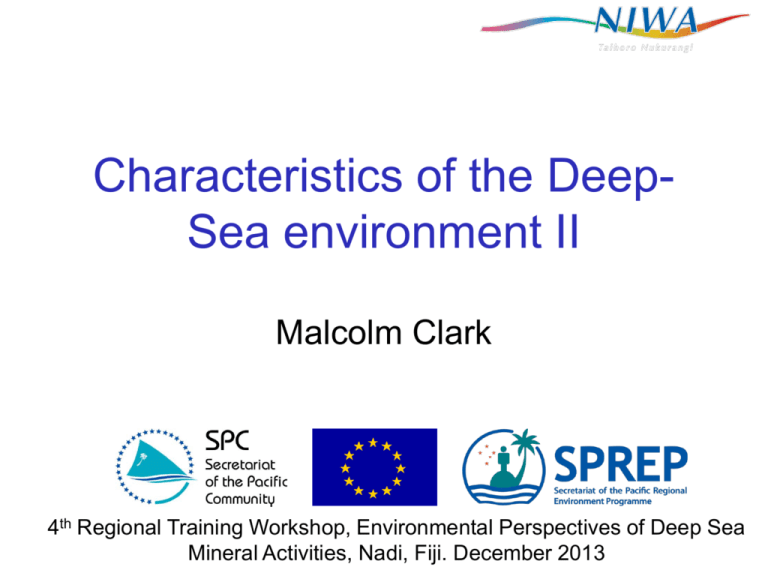
Characteristics of the DeepSea environment II Malcolm Clark 4th Regional Training Workshop, Environmental Perspectives of Deep Sea Mineral Activities, Nadi, Fiji. December 2013 Bathyal and Abyssal regions-the habitats of deep sea resources Vertical changes with depth Depth-diversity • As depth increases, initially there is an increase in diversity • Peaks for many taxa at about 2000 m • Then declines • But still some taxa where diversity remains very high • Especially infauna (more later) Rex & Etter 2010 Species ranges Porcupine Seabight area Gulf of Mexico • Often significant faunal change at mid-slope (A) and lower-slope (B) depths • Fish diversity much less at depth than invertebrates Species ranges (2) • Deep-sea faunal communities: UBB: Upper Boundary Biota (mainly shallow) IBB: Inter-Boundary Biota (intermediate) LBB: Lower Boundary Biota (mainly deep) Carney 2005 Summary of depth zonation • • • • • Our knowledge is limited by sampling and taxonomy – Deep sea is poorly sampled and full of new species – There is a problem with “cryptic diversity” The reasons for depth zonation are not just depth (pressure), but also many related factors such as temperature, water masses, substrates, etc There are general trends in the types of animals present ‒ More filter feeders shallow and more deposit feeders deep ‒ The dominant groups of animals change with depth There are species that have very wide depth ranges and also others with very narrow depth ranges Many species are only found in the deep sea What is there for dinner in the deep? • Food is well recognised as a major limiting factor for animals living in the deep-sea • Feeding mode with depth – Reduction in suspension feeders, increase in deposit feeders – Deeper still, mobile deposit feeders replace sessile deposit feeders – Omnivorous scavengers replace carnivores – Abyssal depths, 50:50 surface and subsurface feeders • Most is derived from surface production (phytoplankton using the sunlight) • Two main strategies – Migrate to the food (vertical migrations) – Wait for the food to come to you Vertical migrations Seamount “effect” • Vertical migrations can be blocked by the shallow summit of the seamount/guyot/ridge • Seamount fishes feed on the plankton Organic matter to the deep • Some from land-based sources • Some large plant remains (e.g., Sargassum) • MOST from small remains of plankton (faecal pellets, phytodetritus) – Animals die, and slowly sink – Much is eaten on the way down, but some makes it (as we will see shortly) • SOME from large animal remains (whales, sharks, squids) Production reduces with depth (flux) Lutz et al. 2007 Surface production is variable Lutz et al. 2007 Porcupine Abyssal Plain • • • • West of the United Kingdom Strong seasonal falls of detritus Irregular “species explosions” Related to large-scale changes in flux of organic matter • The Deep Sea is not necessarily a slow and stable environment, can be dynamic… PAP, 4000 m, May-August 1982 Megafaunal response: Amperima rosea Lag between phytodetritus and megafaunal abundances Reproduction and growth • Seasonality drives many shallow-water processes (where change in day length with season) • Classic predictions – No seasonal breeding time, year-round. – Low fecundity, little pelagic development – Slow growth rates because limited energy environment • But… – is some seasonal reproduction because of advantages of synchronised development – Planktotrophy does occur, but not common – Growth rates are slow, but there are exceptions – Seasonal food pulses are important “Extreme” deep-sea environments • Cindy has talked about the range of topography in the deep-sea • Most is sediment ‒ Abyssal plains are dominated by soft sediment (muds, oozes, sands) • Hard bottom less extensive ‒ Can be small rocks (Manganese nodules) ‒ Mountains (seamounts) and escarpments ‒ Hydrothermal vents ‒ Cold seeps Deep-sea habitat diversity • Expand more (briefly!) on: – Chemosynthetic environments • Hydrothermal vents • Methane-rich seeps • Whale falls – Unusual/severe environments • Oxygen Minimum Zones • Seamounts • Trenches/canyons Hydrothermal vents • Sites of active volcanic activity • Mid-ocean ridges, tectonic plate margins (as in SW Pacific), magma hot-spots • Geothermally heated gases and water plumes rich in minerals and chemicals • Over 500 known active vent sites • Very common in SW Pacific Hydrothermal vent communities • Some animals can utilise hydrogen sulphide, or have chemosynthetic bacteria that convert S-rich fluids into energy (independent of sunlight-driven processes) • Unique faunas: microbes and invertebrates, adapted to specific environmental conditions • Typically not highly diverse – Tubeworms, mussels, snails, barnacles • Very high biomass Vent faunal communities Cold seeps • Seafloor areas where methane and other hydrocarbons seep through sediments • Along continental margins • Interest for their gas hydrate potential • New Zealand, not PICTs • Chemosynthetic processes • Support distinctive seep communities • Tubeworms, clams, mussels • Polychaetes (in sediment) Whale falls • Large animal carcasses are an important source of food in the deep-sea • Whales die (e.g., 1000 grays in NE Pacific/yr) • Large carcasses (30 t) slowly rotting… • Provide abundant sulphide-rich habitat Whale fall (2) • Several colonisation stages – Mobile scavengers (hagfish, sharks, crabs) – Enrichment opportunists (worms) – Sulfophilic stage (chemo. Bacteria, clams, limpets) • Unique species (e.g., carpet worms, snot worms) • Habitat islands (chemosynthetics) • Stepping stones for dispersal? OMZ (Oxygen Minimum Zones) • Ocean areas extremely low in oxygen • Defined as < 0.5 ml/l concentration (usually 4-6 ml/l) • Caused by strong upwelling, with high surface productivity, that then sinks and degrades, depleting oxygen in the water column • Usually bathyal depths, 200 – 1000 m Levin 2003 OMZ (2) • Protozoa can thrive in these conditions • Organic-rich sediments host abundant sulphideoxidising bacteria • Foraminifera abundant, but low diversity • Meiofauna also abundant, again low diversity • Macrofauna and megafauna low densities. Some nematodes/polychaetes are tolerant, and have large respiratory organs, but generally stay away • At very low oxygen levels, chemosynthesis important • Endemism poorly known, but probably high. Seamounts • Elevated seafloor topography, distinct feature • Usually volcanic, commonly formed as “hotspots” • Ecologically important – Provide hard substrate – Extend thousands of metres elevation – Localised oceanography can retain species • • • • • Important for fisheries (more tomorrow) Very poorly sampled Can have high diversity and abundance Especially corals and sponges Important for SMS and CRC resources Canyons • Form deep incisions in shelf and continental margins around the world • Often high current flows, rocky flanks, soft sediment on canyon floor • Diverse, abundant communities • Sponge and corals on flanks, very dense infauna (nematodes in particular) Trenches • Defined as deeper than 6000 m • Occur in areas of subduction of tectonic plates • Western Pacific, Kermadec, Tonga, New Hebrides, Marianas, Japan etc • Deepest fish (about 8000 m), dominated by scavenging amphipods. Low diversity, sometimes very abundant. Most animals small, giant ‘pod. Ongoing scientific studies • A talk in its own right…. • The deep sea is so large, diverse, that so too are the science programmes • Some key elements – – – – Exploration. Biodiversity, what is there? Structure. Multiple habitats, “ecosystem” organisation. Dynamics. How variable, over what spatial scale. Connectivity. Linkages between habitats, depths, ocean basins – Future ocean structure and function-climate change – Human impacts. Fishing, mining, waste disposal, litter • Refer INDEEP “Deep Sea Newsletters” Key Points • Access to the deep sea has improved in recent decades, but understanding the ecology of the deep sea requires expensive ships and technologies. Most of the deep sea remains unexplored. • The deep ocean is complex, with a number of dominant physiographic features well known and other features still to be discovered. • A diverse fauna inhabits the deep sea, with many species undescribed or undiscovered; this fauna varies from one region to the other. • The biological characteristics of deep-sea animals is not well known, but key issues for resilience to human impacts are slow growth rates and reproduction, and adaptations to food-poor conditions. Vinaka New Yorker 1983
